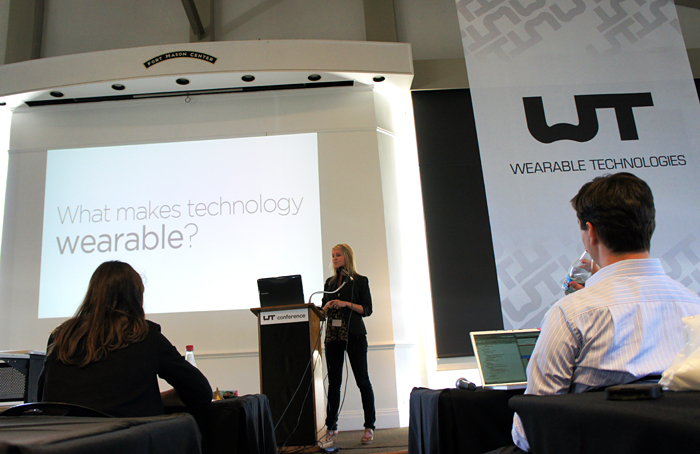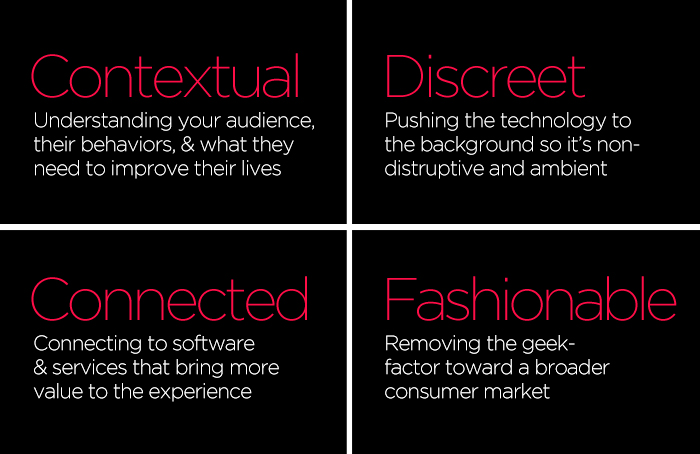I spoke at the Wearable Technology Conference in San Francisco this week and the day was a success! The conference was a packed house with 21 speakers presenting their ideas and new product developments in just one day. It was a sold-out crowd with a wait-list of attendees that ranged from technologists to researchers to start-ups launching new products. It was great to see such a growing interest in this space and I hope this will inspire the coordinators to extend it out for a couple of days instead of just one.
I approached my talk around what makes technology wearable and shared four principles that the industry can use toward creating more compelling consumer products. Others focused on topics such as manufacturing and feasibility. All around, the talks presented opportunities in this space along with mountainous challenges. Even with the barriers, the tone of the room throughout the day confirmed that we are just beginning a wave in this field and everyone there was excited to be on it.

In general, the conference focused on the consumer electronics and technology side of wearables, but was very weak on eTextiles or any of the work that’s being explored with smart fabrics. There were a couple of references to garments, but even those were focused on the ones that had hard-casing components attached to them, not necessarily integrated into the fabric itself. The topics also lacked a user experience perspective and this is an area that we shouldn’t omit from the conversation.
Here are some highlights from the conference:
Power in the software
There was one talk in particular that was very impressive by Dave Dickenson from Zeo Sleep Manager. He was one of the few that presented his sleep management product from the perspective of the user experience and talked about how interpreting sensor data in meaningful ways is one of the core opportunities for these new types of consumer electronic products. I couldn't agree more! He shared with us a catchy phrase that the company uses: Device & Advice, which he defined as taking data from the device, making sense of it and making recommendations to the user on what to do with it. This aligns nicely with one of my principles, Connected, where we have the ability to use software and smart algorithms to interpret the data in more meaningful ways to the user. For example, rather than simply showing you how you slept that night, provide recommendations on what to do to improve your sleep based on that data. This brings more value to the experience and helps people not only understand themselves better (aka quantified self) but understand what to do to improve their lives.
Creative funding for innovation
I enjoyed Eric Migicovsky’s talk from Pebble who presented their story and the overall product experience. What’s interesting about his product is that it represents new business models and ways in which these types of innovations are being funded. Migicovsky and his colleagues raised their funds through Kickstarter, a crowdsourcing investment service, originally asking for $100K but earning over $10Mill with nearly 85K pre-orders! The format is a great low-risk way to get early stage funding while also getting a sense of consumer demand. And in this case, with so much investment, it’s clear that consumers are ready for this type of device.
Trends in form-factors
After Google’s announcement of their new Google Glass concept aimed for prime-time in the short term, headsup displays are all the rage. So I couldn’t help but take notice with Kip Fyfe’s product that he shared from 4iii Innovations. They have developed an attachable device aimed at cyclists that turns your bike shades into a headsup display. It’s a first version product so the styling isn’t quite refined yet, but the product includes an interface that is pushed to the side and in your periphery rather than in front of you and disruptive. Conceptually, this is moving the heads-up display experience in the right direction as opposed to the disruptive experience that I have seen from the Google Glass concept video so far.
Breaking through the manufacturing barrier
It was clear that manufacturing is still a big hurdle in this field. Since wearable technology requires a close collaboration between very different types of products and fields (i.e., electronics vs. garment making) the manufacturing facilities are not set up to handle production for all aspects of these types of products. Dr. Chih-Cheng Lu from AiQ Smart Clothing Lab talked about the variety of products and garment accessories they are making with embedded sensing technology. When making the garments, however, they run into all sorts of manufacturing hurdles due to fragmentation. For example, they develop softgood accessories such as underwear with embedded technologies and have products for both men and women. But the apparel manufacturers specialize in only one or the other so they have to go to one facility to produce the mens underwear and an entirely different facility to produce the women's. Overall, the production workflow is not set up to manufacture these types of products in a streamlined fashion. This adds a lot of logistical complexity and cost to the process.
Powering our devices
Powering wearable devices and getting batteries to a small enough size to be worn is still a big challenge right now. Brooks Kincaid from Imprint Energy gave an inspiring talk about improvements in batteries made specifically for wearable technology. He shared his super-thin solution that is as thin as a sheet of paper, bendable and you can even punch a hole in it without effecting the performance and power. The only downer for his product is that it won’t be available for another 2 or 3 years. Nonetheless, it’s a promising advancement in this space.
Applying the four principles

Collectively, the talks presented ideas and new products that could really benefit from applying the four foundational principles to their experience: contextual, discreet, connected, and fashionable. Most products are doing one or two of these, but lack the others. It’s a step forward in carving out a new field, but as the industry matures, so will the need to apply better end-to-end processes and methods of design and development. I would like to see more thinking across these four principles, which will help us create much more compelling consumer experiences and technology products that we want to wear and that, ultimately, improve our lives.
For more info on the four principles, go to the article here.
For more info on the conference, go to their site here.


